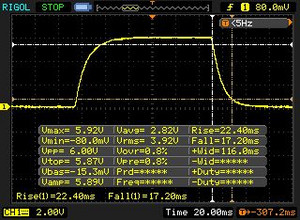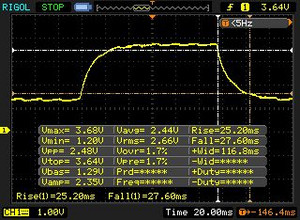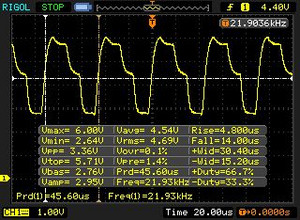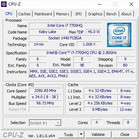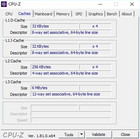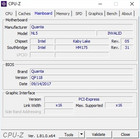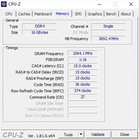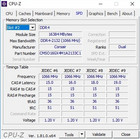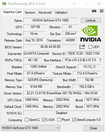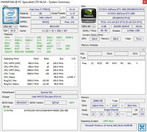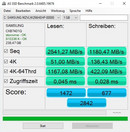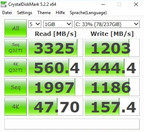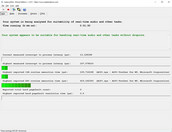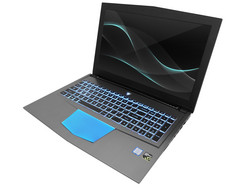Breve análisis del portátil PC Specialist Proteus V (i7-7700HQ, GTX 1060, Full-HD)
Top 10 Análisis
» Top 10 Portátiles Multimedia
» Top 10 Portátiles de Juego
» Top 10 Portátiles de Juego ligeros
» Top 10 Portátiles Asequibles de Oficina/Empresa
» Top 10 Portátiles de Juego Ligeros
» Top 10 Portátiles de Oficina/Empresa Premium
» Top 10 Estaciones de Trabajo
» Top 10 Subportátiles
» Top 10 Ultrabooks
» Top 10 Convertibles
» Top 10 Tablets
» Top 10 Tablets Windows
» Top 10 Tablets de menos de 250 Euros
» Top 10 Phablets (>5.5")
» Top 10 Smartphones
» Top 10 Smartphones (≤5")
» Top 10 Smartphones de menos de 300 Euros
» Top 10 Smartphones de menos de 120 Euros
» Top 10 Portátiles de menos de 1000 Euros
» Top 10 Portátiles de menos de 500 Euros
» Top 10 Portátiles de menos de 300 Euros
» Los Mejores Displays de Portátiles Analizados por Notebookcheck
| SD Card Reader | |
| average JPG Copy Test (av. of 3 runs) | |
| PC Zentrum Proteus V (Toshiba Exceria Pro SDXC 64 GB UHS-II) | |
| Schenker XMG Core 15 (Toshiba Exceria Pro SDXC 64 GB UHS-II) | |
| Gigabyte P55W v7 (Toshiba Exceria Pro SDXC 64 GB UHS-II) | |
| MSI GS63VR 7RF-228US (Toshiba Exceria Pro SDXC 64 GB UHS-II) | |
| Acer Aspire VN7-593G-73HP V15 Nitro BE | |
| maximum AS SSD Seq Read Test (1GB) | |
| PC Zentrum Proteus V (Toshiba Exceria Pro SDXC 64 GB UHS-II) | |
| Gigabyte P55W v7 (Toshiba Exceria Pro SDXC 64 GB UHS-II) | |
| Schenker XMG Core 15 (Toshiba Exceria Pro SDXC 64 GB UHS-II) | |
| Acer Aspire VN7-593G-73HP V15 Nitro BE | |
| MSI GS63VR 7RF-228US (Toshiba Exceria Pro SDXC 64 GB UHS-II) | |
| |||||||||||||||||||||||||
iluminación: 85 %
Brillo con batería: 242 cd/m²
Contraste: 1152:1 (Negro: 0.21 cd/m²)
ΔE ColorChecker Calman: 4.27 | ∀{0.5-29.43 Ø4.77}
ΔE Greyscale Calman: 2.17 | ∀{0.09-98 Ø5}
58% sRGB (Argyll 1.6.3 3D)
37% AdobeRGB 1998 (Argyll 1.6.3 3D)
40.42% AdobeRGB 1998 (Argyll 3D)
58% sRGB (Argyll 3D)
39.13% Display P3 (Argyll 3D)
Gamma: 2.38
CCT: 6912 K
| PC Zentrum Proteus V BOEhydis NV156FHM-N42 (BOE06C6), 1920x1080, 15.6" | Schenker XMG Core 15 LG Philips LP156WF6 (LGD046F), 1920x1080, 15.6" | MSI GS63VR 7RF-228US 3840x2160, 15.6" | Acer Aspire VN7-593G-73HP V15 Nitro BE LG Display LP156WF6-SPP1, 1920x1080, 15.6" | Gigabyte P55W v7 LG Philips LP156WF6 (LGD046F), 1920x1080, 15.6" | |
|---|---|---|---|---|---|
| Display | 52% | 24% | 56% | 50% | |
| Display P3 Coverage (%) | 39.13 | 64.3 64% | 48.21 23% | 65.8 68% | 63.5 62% |
| sRGB Coverage (%) | 58 | 83 43% | 72.6 25% | 85.1 47% | 82 41% |
| AdobeRGB 1998 Coverage (%) | 40.42 | 60.6 50% | 49.81 23% | 62.2 54% | 59.9 48% |
| Response Times | 23% | 44% | 18% | 34% | |
| Response Time Grey 50% / Grey 80% * (ms) | 52.8 ? | 40.8 ? 23% | 28 ? 47% | 41 ? 22% | 37 ? 30% |
| Response Time Black / White * (ms) | 39.6 ? | 30.4 ? 23% | 23.6 ? 40% | 34 ? 14% | 25 ? 37% |
| PWM Frequency (Hz) | 21930 ? | 20490 ? | 1351 ? | ||
| Screen | -11% | -59% | -2% | -6% | |
| Brightness middle (cd/m²) | 242 | 297 23% | 274.2 13% | 322 33% | 287 19% |
| Brightness (cd/m²) | 235 | 276 17% | 263 12% | 297 26% | 289 23% |
| Brightness Distribution (%) | 85 | 87 2% | 92 8% | 86 1% | 87 2% |
| Black Level * (cd/m²) | 0.21 | 0.3 -43% | 0.44 -110% | 0.31 -48% | 0.29 -38% |
| Contrast (:1) | 1152 | 990 -14% | 623 -46% | 1039 -10% | 990 -14% |
| Colorchecker dE 2000 * | 4.27 | 5.25 -23% | 8 -87% | 4.73 -11% | 4.92 -15% |
| Colorchecker dE 2000 max. * | 7.09 | 10.3 -45% | 14.6 -106% | 12.37 -74% | 11 -55% |
| Greyscale dE 2000 * | 2.17 | 4.64 -114% | 9.1 -319% | 2.99 -38% | 3.66 -69% |
| Gamma | 2.38 92% | 2.39 92% | 2.24 98% | 2.32 95% | 2.32 95% |
| CCT | 6912 94% | 6600 98% | 5020 129% | 6905 94% | 6482 100% |
| Color Space (Percent of AdobeRGB 1998) (%) | 37 | 54 46% | 45.7 24% | 56 51% | 54 46% |
| Color Space (Percent of sRGB) (%) | 58 | 83 43% | 72.1 24% | 85 47% | 82 41% |
| Media total (Programa/Opciones) | 21% /
6% | 3% /
-29% | 24% /
12% | 26% /
11% |
* ... más pequeño es mejor
Tiempos de respuesta del display
| ↔ Tiempo de respuesta de Negro a Blanco | ||
|---|---|---|
| 39.6 ms ... subida ↗ y bajada ↘ combinada | ↗ 22.4 ms subida | |
| ↘ 17.2 ms bajada | ||
| La pantalla mostró tiempos de respuesta lentos en nuestros tests y podría ser demasiado lenta para los jugones. En comparación, todos los dispositivos de prueba van de ##min### (mínimo) a 240 (máximo) ms. » 97 % de todos los dispositivos son mejores. Eso quiere decir que el tiempo de respuesta es peor que la media (20.2 ms) de todos los dispositivos testados. | ||
| ↔ Tiempo de respuesta 50% Gris a 80% Gris | ||
| 52.8 ms ... subida ↗ y bajada ↘ combinada | ↗ 25.2 ms subida | |
| ↘ 27.6 ms bajada | ||
| La pantalla mostró tiempos de respuesta lentos en nuestros tests y podría ser demasiado lenta para los jugones. En comparación, todos los dispositivos de prueba van de ##min### (mínimo) a 636 (máximo) ms. » 89 % de todos los dispositivos son mejores. Eso quiere decir que el tiempo de respuesta es peor que la media (31.6 ms) de todos los dispositivos testados. | ||
Parpadeo de Pantalla / PWM (Pulse-Width Modulation)
| Parpadeo de Pantalla / PWM detectado | 21930 Hz | ≤ 95 % de brillo | |
La retroiluminación del display parpadea a 21930 Hz (seguramente usa PWM - Pulse-Width Modulation) a un brillo del 95 % e inferior. Sobre este nivel de brillo no debería darse parpadeo / PWM. La frecuencia de 21930 Hz es bastante alta, por lo que la mayoría de gente sensible al parpadeo no debería ver parpadeo o tener fatiga visual. Comparación: 53 % de todos los dispositivos testados no usaron PWM para atenuar el display. Si se usó, medimos una media de 8088 (mínimo: 5 - máxmo: 343500) Hz. | |||
| Cinebench R11.5 | |
| CPU Single 64Bit | |
| Schenker XMG Core 15 | |
| MSI GS63VR 7RF-228US | |
| PC Zentrum Proteus V | |
| CPU Multi 64Bit | |
| MSI GS63VR 7RF-228US | |
| PC Zentrum Proteus V | |
| Schenker XMG Core 15 | |
| PCMark 8 - Home Score Accelerated v2 | |
| PC Zentrum Proteus V | |
| Schenker XMG Core 15 | |
| MSI GS63VR 7RF-228US | |
| Gigabyte P55W v7 | |
| PCMark 10 - Score | |
| Schenker XMG Core 15 | |
| PC Zentrum Proteus V | |
| PCMark 8 Home Score Accelerated v2 | 4916 puntos | |
| PCMark 10 Score | 3904 puntos | |
ayuda | ||
| PC Zentrum Proteus V Samsung PM961 MZVLW256HEHP | Schenker XMG Core 15 Samsung SSD 960 Evo 250GB m.2 NVMe | MSI GS63VR 7RF-228US Samsung SM961 MZVKW512HMJP m.2 PCI-e | Acer Aspire VN7-593G-73HP V15 Nitro BE Seagate Mobile HDD 1TB ST1000LM035 | Gigabyte P55W v7 Liteonit CV3-8D256 | |
|---|---|---|---|---|---|
| AS SSD | 20% | 26% | -68% | ||
| Seq Read (MB/s) | 2541 | 2678 5% | 2719 7% | 514 -80% | |
| Seq Write (MB/s) | 1180 | 1172 -1% | 1550 31% | 328.1 -72% | |
| 4K Read (MB/s) | 51 | 46.56 -9% | 48.01 -6% | 23.34 -54% | |
| 4K Write (MB/s) | 136.4 | 142.9 5% | 127.6 -6% | 48.47 -64% | |
| Score Read (Points) | 1472 | 1639 11% | 1549 5% | 393 -73% | |
| Score Write (Points) | 677 | 1323 95% | 1468 117% | 248 -63% | |
| Score Total (Points) | 2842 | 3728 31% | 3756 32% | 840 -70% |
| 3DMark - 1920x1080 Fire Strike Graphics | |
| PC Zentrum Proteus V | |
| Acer Aspire VN7-593G-73HP V15 Nitro BE | |
| Gigabyte P55W v7 | |
| Schenker XMG Core 15 | |
| MSI GS63VR 7RF-228US | |
| 3DMark 11 - 1280x720 Performance GPU | |
| PC Zentrum Proteus V | |
| Acer Aspire VN7-593G-73HP V15 Nitro BE | |
| Gigabyte P55W v7 | |
| Schenker XMG Core 15 | |
| MSI GS63VR 7RF-228US | |
| 3DMark 11 Performance | 12205 puntos | |
| 3DMark Ice Storm Standard Score | 143270 puntos | |
| 3DMark Cloud Gate Standard Score | 26044 puntos | |
| 3DMark Fire Strike Score | 10010 puntos | |
ayuda | ||
| The Witcher 3 | |
| 1920x1080 Ultra Graphics & Postprocessing (HBAO+) | |
| PC Zentrum Proteus V | |
| MSI GS63VR 7RF-228US | |
| Gigabyte P55W v7 | |
| Acer Aspire VN7-593G-73HP V15 Nitro BE | |
| Schenker XMG Core 15 | |
| 1920x1080 High Graphics & Postprocessing (Nvidia HairWorks Off) | |
| MSI GS63VR 7RF-228US | |
| PC Zentrum Proteus V | |
| Gigabyte P55W v7 | |
| Schenker XMG Core 15 | |
| Acer Aspire VN7-593G-73HP V15 Nitro BE | |
| bajo | medio | alto | ultra | |
|---|---|---|---|---|
| The Witcher 3 (2015) | 72.2 | 39.9 | ||
| Middle-earth: Shadow of War (2017) | 68 | 52 | ||
| The Evil Within 2 (2017) | 43.4 | 41.8 | ||
| ELEX (2017) | 68.1 | 51.9 | ||
| Destiny 2 (2017) | 94.1 | 78.4 | ||
| Wolfenstein II: The New Colossus (2017) | 77.4 | 70.7 | ||
| Assassin´s Creed Origins (2017) | 57 | 47 | ||
| Call of Duty WWII (2017) | 93.8 | 70.4 | ||
| Need for Speed Payback (2017) | 77.8 | 73.7 | ||
| Star Wars Battlefront 2 (2017) | 80.6 | 62.3 |
Ruido
| Ocioso |
| 37 / 38 / 39 dB(A) |
| Carga |
| 47 / 52 dB(A) |
 | ||
30 dB silencioso 40 dB(A) audible 50 dB(A) ruidosamente alto |
||
min: | ||
| PC Zentrum Proteus V GeForce GTX 1060 Mobile, i7-7700HQ | Schenker XMG Core 15 GeForce GTX 1060 Mobile, i7-7700HQ | MSI GS63VR 7RF-228US GeForce GTX 1060 Mobile, i7-7700HQ | Acer Aspire VN7-593G-73HP V15 Nitro BE GeForce GTX 1060 Mobile, i7-7700HQ | Gigabyte P55W v7 GeForce GTX 1060 Mobile, i7-7700HQ | |
|---|---|---|---|---|---|
| Noise | 12% | 10% | 11% | 9% | |
| apagado / medio ambiente * (dB) | 31 | 29 6% | 28.8 7% | 30.4 2% | 30 3% |
| Idle Minimum * (dB) | 37 | 31 16% | 33.1 11% | 30.9 16% | 33 11% |
| Idle Average * (dB) | 38 | 32 16% | 33.1 13% | 30.9 19% | 34 11% |
| Idle Maximum * (dB) | 39 | 34 13% | 34 13% | 31.5 19% | 35 10% |
| Load Average * (dB) | 47 | 41 13% | 37.2 21% | 40.7 13% | 39 17% |
| Witcher 3 ultra * (dB) | 43 | 39 9% | 46.1 -7% | 45.5 -6% | |
| Load Maximum * (dB) | 52 | 47 10% | 47.1 9% | 43.9 16% | 50 4% |
* ... más pequeño es mejor
(±) La temperatura máxima en la parte superior es de 44 °C / 111 F, frente a la media de 40.4 °C / 105 F, que oscila entre 21.2 y 68.8 °C para la clase Gaming.
(-) El fondo se calienta hasta un máximo de 53 °C / 127 F, frente a la media de 43.3 °C / 110 F
(+) En reposo, la temperatura media de la parte superior es de 26.9 °C / 80# F, frente a la media del dispositivo de 33.9 °C / 93 F.
(±) Jugando a The Witcher 3, la temperatura media de la parte superior es de 36.6 °C / 98 F, frente a la media del dispositivo de 33.9 °C / 93 F.
(+) Los reposamanos y el panel táctil alcanzan como máximo la temperatura de la piel (33 °C / 91.4 F) y, por tanto, no están calientes.
(-) La temperatura media de la zona del reposamanos de dispositivos similares fue de 28.8 °C / 83.8 F (-4.2 °C / -7.6 F).
| PC Zentrum Proteus V GeForce GTX 1060 Mobile, i7-7700HQ | Schenker XMG Core 15 GeForce GTX 1060 Mobile, i7-7700HQ | MSI GS63VR 7RF-228US GeForce GTX 1060 Mobile, i7-7700HQ | Acer Aspire VN7-593G-73HP V15 Nitro BE GeForce GTX 1060 Mobile, i7-7700HQ | Gigabyte P55W v7 GeForce GTX 1060 Mobile, i7-7700HQ | |
|---|---|---|---|---|---|
| Heat | -23% | 0% | -6% | 8% | |
| Maximum Upper Side * (°C) | 44 | 53 -20% | 51.9 -18% | 49.6 -13% | |
| Maximum Bottom * (°C) | 53 | 61 -15% | 54.6 -3% | 47.7 10% | |
| Idle Upper Side * (°C) | 29 | 35 -21% | 28.4 2% | 29.1 -0% | 23.6 19% |
| Idle Bottom * (°C) | 29 | 39 -34% | 29.6 -2% | 29.3 -1% | 24.6 15% |
* ... más pequeño es mejor
PC Zentrum Proteus V análisis de audio
(-) | altavoces no muy altos (#65 dB)
Graves 100 - 315 Hz
(±) | lubina reducida - en promedio 9.3% inferior a la mediana
(±) | la linealidad de los graves es media (14.5% delta a frecuencia anterior)
Medios 400 - 2000 Hz
(+) | medios equilibrados - a sólo 3.5% de la mediana
(±) | la linealidad de los medios es media (7% delta respecto a la frecuencia anterior)
Altos 2 - 16 kHz
(+) | máximos equilibrados - a sólo 2.8% de la mediana
(±) | la linealidad de los máximos es media (8.9% delta a frecuencia anterior)
Total 100 - 16.000 Hz
(±) | la linealidad del sonido global es media (22.6% de diferencia con la mediana)
En comparación con la misma clase
» 81% de todos los dispositivos probados de esta clase eran mejores, 5% similares, 14% peores
» El mejor tuvo un delta de 6%, la media fue 18%, el peor fue ###max##%
En comparación con todos los dispositivos probados
» 66% de todos los dispositivos probados eran mejores, 6% similares, 29% peores
» El mejor tuvo un delta de 4%, la media fue 24%, el peor fue ###max##%
Schenker XMG Core 15 análisis de audio
(±) | la sonoridad del altavoz es media pero buena (75 dB)
Graves 100 - 315 Hz
(±) | lubina reducida - en promedio 8% inferior a la mediana
(±) | la linealidad de los graves es media (11.7% delta a frecuencia anterior)
Medios 400 - 2000 Hz
(±) | medias más altas - de media 10.1% más altas que la mediana
(±) | la linealidad de los medios es media (13.2% delta respecto a la frecuencia anterior)
Altos 2 - 16 kHz
(+) | máximos equilibrados - a sólo 1.9% de la mediana
(±) | la linealidad de los máximos es media (7.5% delta a frecuencia anterior)
Total 100 - 16.000 Hz
(±) | la linealidad del sonido global es media (23.6% de diferencia con la mediana)
En comparación con la misma clase
» 85% de todos los dispositivos probados de esta clase eran mejores, 4% similares, 11% peores
» El mejor tuvo un delta de 6%, la media fue 18%, el peor fue ###max##%
En comparación con todos los dispositivos probados
» 70% de todos los dispositivos probados eran mejores, 6% similares, 24% peores
» El mejor tuvo un delta de 4%, la media fue 24%, el peor fue ###max##%
| Off / Standby | |
| Ocioso | |
| Carga |
|
Clave:
min: | |
| PC Zentrum Proteus V GeForce GTX 1060 Mobile, i7-7700HQ | Schenker XMG Core 15 GeForce GTX 1060 Mobile, i7-7700HQ | MSI GS63VR 7RF-228US GeForce GTX 1060 Mobile, i7-7700HQ | Acer Aspire VN7-593G-73HP V15 Nitro BE GeForce GTX 1060 Mobile, i7-7700HQ | Gigabyte P55W v7 GeForce GTX 1060 Mobile, i7-7700HQ | |
|---|---|---|---|---|---|
| Power Consumption | 14% | 28% | 35% | 41% | |
| Idle Minimum * (Watt) | 28 | 18 36% | 14.5 48% | 7.2 74% | 8 71% |
| Idle Average * (Watt) | 32 | 22 31% | 17.3 46% | 10.5 67% | 13 59% |
| Idle Maximum * (Watt) | 38 | 26 32% | 17.4 54% | 16 58% | 18 53% |
| Load Average * (Watt) | 91 | 93 -2% | 93 -2% | 82 10% | 76 16% |
| Witcher 3 ultra * (Watt) | 124 | 119 4% | 128.8 -4% | 124 -0% | |
| Load Maximum * (Watt) | 152 | 175 -15% | 155 -2% | 143 6% |
* ... más pequeño es mejor
| PC Zentrum Proteus V GeForce GTX 1060 Mobile, i7-7700HQ, Wh | Schenker XMG Core 15 GeForce GTX 1060 Mobile, i7-7700HQ, 82 Wh | MSI GS63VR 7RF-228US GeForce GTX 1060 Mobile, i7-7700HQ, 65 Wh | Acer Aspire VN7-593G-73HP V15 Nitro BE GeForce GTX 1060 Mobile, i7-7700HQ, 69 Wh | Gigabyte P55W v7 GeForce GTX 1060 Mobile, i7-7700HQ, 63 Wh | |
|---|---|---|---|---|---|
| Duración de Batería | 21% | 26% | 90% | 113% | |
| Reader / Idle (h) | 3.7 | 5 35% | 6.4 73% | 8.4 127% | 13.2 257% |
| H.264 (h) | 3.3 | 3.9 18% | |||
| WiFi v1.3 (h) | 3.3 | 4.7 42% | 3.9 18% | 6 82% | 5.8 76% |
| Load (h) | 1.5 | 1.3 -13% | 1.3 -13% | 2.4 60% | 1.6 7% |
Pro
Contra
Si el aguante de la batería no es importante y tampoco lo son los altavoces internos para escuchar música, ver películas o jugar juegos, entonces el Proteus V de PC Specialist puede ser una alternativa viable a un precio justo. Además de la elegante carcasa hecha de aluminio, también nos gustaron los dispositivos de entrada.
Su rendimiento general es más que decente. Equipado con 16 GB de RAM DDR4 y un SSD, el Proteus V puede mantenerse al día con los gustos de Acer, Asus o MSI. Los juegos modernos funcionan sin problemas en la resolución FHD nativa del dispositivo de 1920 x 1080 gracias al procesador Core i7-7700HQ y la tarjeta gráfica GTX 1060.
Desafortunadamente, la pantalla FHD resultó ser bastante pobre. A pesar de su alto índice de contraste y bajo nivel de negro, simplemente no se ilumina lo suficiente como para dejar una impresión positiva duradera, y tiene una cobertura de espacio de color inferior. Los controles de velocidad de los ventiladores necesitan una renovación masiva tan pronto como sea posible. Las bajas temperaturas del dispositivo son una señal de que los ventiladores giran demasiado fuerte; ventiladores con el potencial de molestar a los usuarios del portátil con bastante rapidez. Con suerte, el Especialista en PC mejorará esto con una futura actualización de BIOS.
Por lo tanto, a fecha de redacción, preferiríamos recomendar el Schenker XMG Core 15, algo más cálido pero significativamente más silencioso, a pesar de la falta de superficies metálicas brillantes. Pueden encontrar otros competidores de 15" en nuestra top 10 (ligeros) y en página de pruebas de la GTX 1060.
Ésta es una versión acortada del análisis original. Puedes leer el análisis completo en inglés aquí.
PC Zentrum Proteus V
- 12/16/2017 v6 (old)
Florian Glaser






